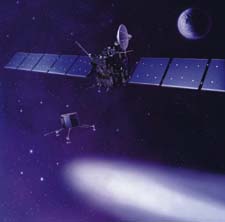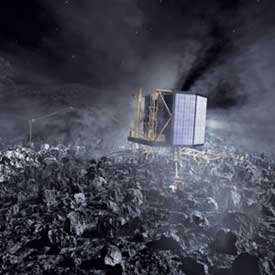
An artist's impression of the Rosetta spacecraft and its lander. A problem with Rosetta's Ariane 5 launch vehicle postponed the mission's liftoff from January 12th until today, forcing European space planners to find a new target for their flagship mission.
Courtesy European Space Agency.
After a year of delays and setbacks, the European Space Agency's Rosetta spacecraft successfully launched this morning from French Guiana. The ambitious mission will rendezvous with Comet 67P/Churyumov-Gerasimenko in 2014 and, for the first time in space history, deploy a lander onto the icy nucleus. With a sentinel on the surface of the comet, scientists hope to use this ancient solar-system relic to help understand the formation of planetary systems.
Relying only on solar cells for power, Rosetta will make several flybys of Earth and Mars to gain the momentum needed for its 10-year journey past the main asteroid belt. At interception, the comet will be about 4.5 astronomical units from the Sun. There Rosetta will orbit the 4-kilometer-wide icy dirtball and map its surface for several months. These observations will be critical before Rosetta casts its robotic lander, Ptolemy, onto the uncertain surface.

Rosetta's lander, named Ptolemy, is equipped with harpoons and drills in its feet that will secure the craft onto the comet's surface.
Courtesy ESA.
Equipped with 10 internationally funded instruments, the small lander is designed to tether itself to the low-gravity comet and analyze the chemical and physical composition of the nucleus. Experiments include measuring precise carbon-isotope ratios as well as returning the first images from a comet's surface.
The orbiter itself will accompany 67P/Churyumov-Gerasimenko for nearly two years on its journey toward the Sun, giving scientists a chance to see firsthand the metamorphosis that a warming comet undergoes.
The Rosetta mission is a cornerstone of ESA's planetary campaign, coming on the heels of last year's Mars Express mission and the Earth-Moon mission SMART 1. The agency's consortium of 15 European member states has future planetary projects as well, including the 2005 Venus Express and an orbiter mission set to fly to Mercury by the end of the decade.
 0
0
Comments
You must be logged in to post a comment.